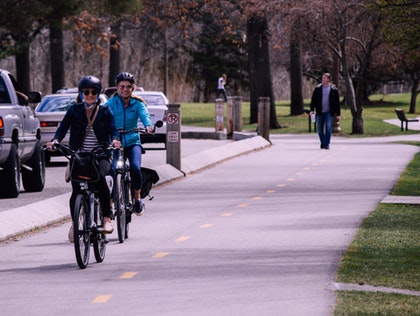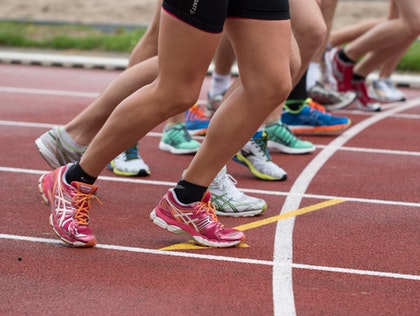In this article, we briefly discuss the safety precautions of some sporting activities, such as tennis, cycling, and athletics.
It is now advised that pregnant women should participate in moderate-intensity exercise for at least 150 minutes per week. This could help in the following:
1. Decreasing the risk of depression by 25%,
2. Decreasing the risk of gestational diabetes and preeclampsia by 40%.
However, the American College of Obstetrician and Gynaecologists (ACOG) and the UK National Health Service (NHS) advise to avoid the following:
1. Contact sports that can cause injury to abdomen/ bump:
Examples include football, basketball, ice-hockey, boxing, rugby, tennis, squash, martial arts, kickboxing, judo.
2. Sports that cause fall/ injury:
Examples include horse riding, snow or water skiing, surfing, cycling, gymnastics
3. Sports that can cause decompression sickness/ air embolism, such as Scuba diving.
4. High altitude sports which can cause altitude sickness.
5. Exercise on lying back.
If you still choose to continue any of the other activities during pregnancy, then the following are strongly advisable:
1. First of all, speak to your healthcare providers (midwife, doctor, obstetrician, etc.) to ensure it is safe for you.
2. Inform your trainer/ coach/ instructor that you are pregnant.
3. Stay hydrated.
4. Avoid high core body temperature:
Avoid adverse weather conditions, especially too hot conditions. The body’s temperature regulation system undergoes significant changes during pregnancy. Therefore, you may develop overheating (‘hyperthermia’).
5. Warm-up and cool down.
6. Stop if you feel uncomfortable or unwell and before you become too tired/ exhausted.
7. Take adequate rest.
8. Ensure adequate clothing.
9. Be aware of the changes in your posture, balance, and gait during pregnancy.
10. It is advisable that you do not start the above sports the first time during pregnancy. You should only continue if you are a fully trained, skilled, and experienced and you have clearly understood the risks involved.
Some specific considerations are as follows:
(Please note that this information is for very fit, trained and experienced in these activities and participated regularly on high-intensity exercise before pregnancy)

TENNIS
1. Appropriate clothing, such as sports bra/ extra supportive bra and loose-fitting sports clothes. You may try abdominal support if the movement of the bump causes discomfort.
2. Good quality footwear will help to prevent ankle/ tendon injuries.
3. The size of the tennis shoes might need to change if you develop foot/ ankle swelling.
4. Avoid over-stretching your body such as during hard serves or hitting the ball overheads or chasing wide balls. You are more prone to lose your balance and fall and sustain an injury.
5. The intensity of the play might need to be modified. Therefore, adopt a common-sense approach.
6. Be very careful about the quick turns and fast movements as there are changes with posture and balance during pregnancy.
7. If you find covering the entire court uncomfortable during the Singles, you may consider playing in Doubles (especially during the third trimesters).
8. If you are playing outdoors, avoid very hot weather. Stay hydrated with frequent breaks to drink water. Use a hat or a visor might also help in the hot weather.
9. Do not take up tennis as a new sporting activity. Preferable avoid playing tennis if you are a beginner and still trying to learn/ develop the skills. Otherwise, you may increase the risk of fall and injury.
10. Apply your own judgment before you enroll and participate in competitive matches/ tournaments, avoid if possible.
11. Trauma to the bump with a tennis ball during second and third trimesters is an important risk. Always inform your opponent about your pregnancy and agree to avoid any overheads aimed towards your body.
12. After giving birth, start playing tennis gradually.

CYCLING (Off-Road)
1. Avoid fall and crash:
– Avoid cycling if it is raining or the roads are slippery to prevent fall.
– Learn about the changes in posture and balance during pregnancy.
– Take familiar and safer routes.
2. Avoid pressure on your back:
Raise the handlebars with an erg stem during the late second and third trimesters. This will help you to sit in a more upright posture therefore, avoid leaning forward and straining the back.
3. Avoid overheating:
– avoid cycling in very hot weather.
– avoid long and strenuous journeys on the bike.
– Take breaks
4. Reduce the intensity of cycling and monitor the heart rate. The heart rate should stay below 140 beats per minute (as per the recommendations).
5. Stay hydrated.
6. May consider cycling indoors.
7. Have realistic expectations:
You might feel tired and exhausted easily during pregnancy or might have nausea or backache. So, you may not meet a planned workout sometimes. But do not get disheartened or stressed.
8. Static cycling is safe and should be encouraged.
9. Always listen to your body.
10. You may need to alter the position of the saddle as the pregnancy advances, to stay more comfortable

ATHLETICS
1. Use a maternity support belt and a supportive sports bra to minimise discomfort.
2. Reduce the intensity: most pregnant athletes report a reduction of intensity by 30-40%.
3. Avoid long-distance running, such as a marathon, if possible.

